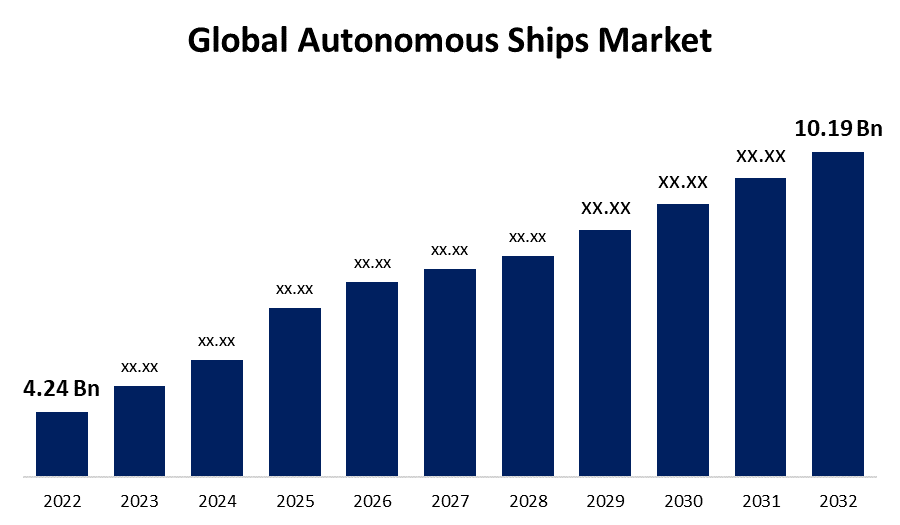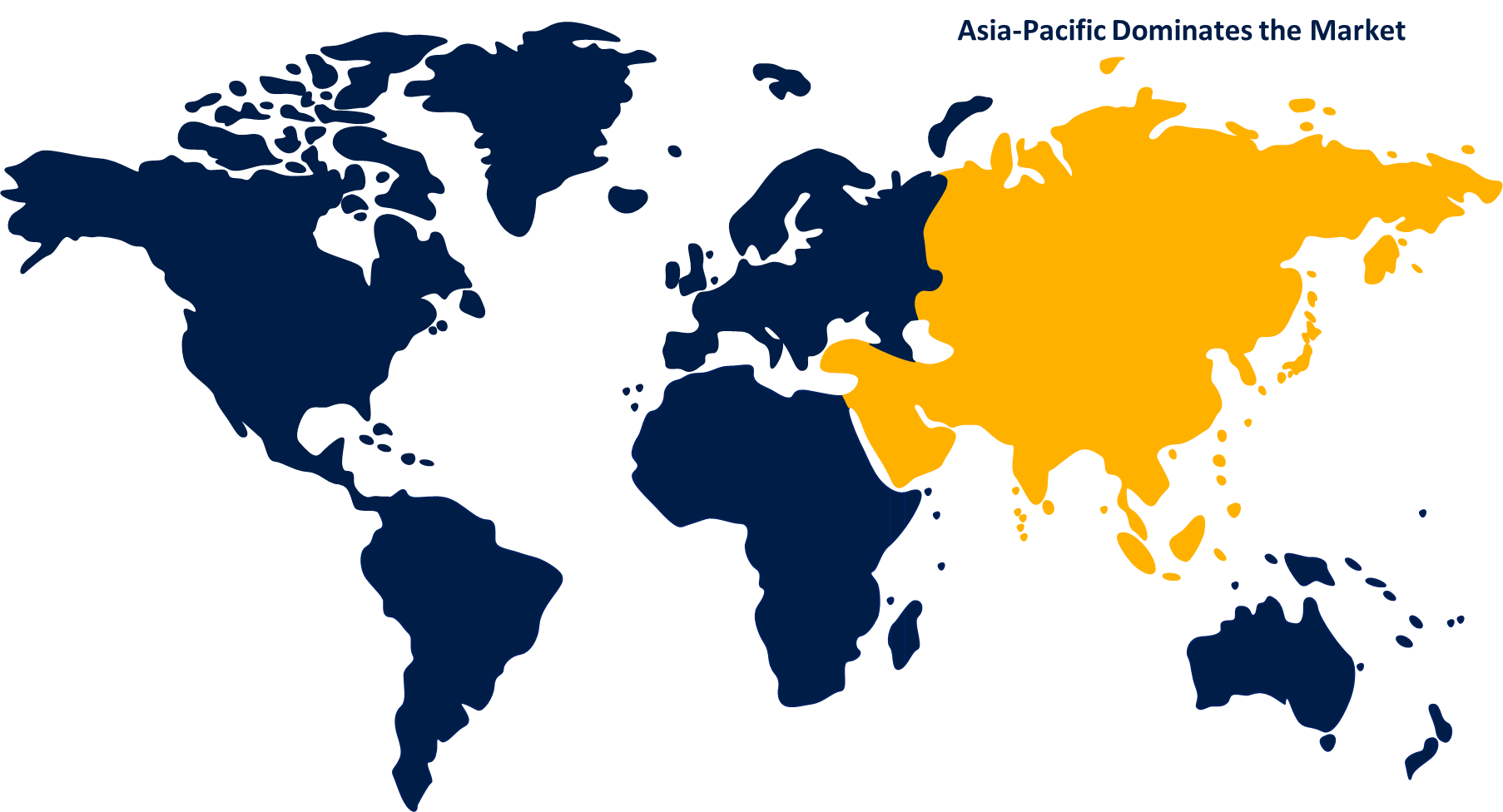Global Autonomous Ships Market Size, Share, and COVID-19 Impact Analysis, By Autonomy (Partial Automation, Remotely Operated, and Fully Autonomous), By Solution (Hardware and Software), By Ship Type (Commercial and Defense), By End User (Line Fit and Retrofit), and By Region (North America, Europe, Asia-Pacific, Latin America, Middle East, and Africa), Analysis and Forecast 2022 – 2032
Industry: Aerospace & DefenseGlobal Autonomous Ships Market Insights Forecasts to 2032
- The Global Autonomous Ships Market Size was valued at USD 4.24 Billion in 2022.
- The Market is Growing at a CAGR of 9.2% from 2022 to 2032
- The Worldwide Autonomous Ships Market Size is expected to reach USD 10.19 Billion by 2032
- North America is expected to grow at a significant CAGR during the forecast period

Get more details on this report -
The Global Autonomous Ships Market Size is anticipated to exceed USD 10.19 Billion by 2032, growing at a CAGR of 9.2% from 2022 to 2032. Increasing investments in autonomous ship ventures from many countries around the world, acceptance of entirely autonomous commercial and military vessels, and increased use of automated systems to minimize human error are all projected to support the expansion of autonomous ships.
Market Overview
The global autonomous ships market is a rapidly developing sector of the maritime industry involving the development, deployment, and use of unmanned and self-navigating vessels. This market represents a paradigm shift from traditional crewed ships to technologically advanced vessels that navigate and operate autonomously using cutting-edge technologies such as artificial intelligence, sensors, GPS, radar systems, and advanced communication networks. By eliminating the need for onboard crew members, autonomous ships aim to improve operational efficiency, reduce human errors, increase safety, and potentially lower operational costs. Cargo ships, container carriers, oil tankers, research vessels, and even passenger ferries are examples of these vessels. Factors driving market growth include increased demand for efficient and sustainable maritime transportation solutions, advancements in automation technologies, and a growing emphasis on reducing greenhouse gas emissions in the shipping industry. Regulatory hurdles, safety concerns, and the need to establish a comprehensive framework for remote monitoring and control are among the challenges associated with the global autonomous ships market. Furthermore, collaboration among maritime stakeholders, technology providers, and regulatory bodies is critical to ensuring autonomous ships' seamless integration into the existing maritime ecosystem. The global autonomous ships market has the potential to reshape the future of maritime transportation as technology matures and regulatory frameworks evolve.
Report Coverage
This research report categorizes the market for the global autonomous ships market based on various segments and regions and forecasts revenue growth and analyzes trends in each submarket. The report analyses the key growth drivers, opportunities, and challenges influencing the autonomous ships market. Recent market developments and competitive strategies such as expansion, product launch, and development, partnership, merger, and acquisition have been included to draw the competitive landscape in the market. The report strategically identifies and profiles the key market players and analyses their core competencies in each sub-segment of the autonomous ships market.
Global Autonomous Ships Market Report Coverage
| Report Coverage | Details |
|---|---|
| Base Year: | 2022 |
| Market Size in 2022: | USD 4.24 Billion |
| Forecast Period: | 2022-2032 |
| Forecast Period CAGR 2022-2032 : | 9.2% |
| 2032 Value Projection: | USD 10.19 Billion |
| Historical Data for: | 2018-2021 |
| No. of Pages: | 200 |
| Tables, Charts & Figures: | 110 |
| Segments covered: | By Autonomy, By Solution, By Ship Type, By End User, By Region and COVID-19 Impact Analysis. |
| Companies covered:: | BAE Systems, GE, Honeywell International Inc., Kongsberg Maritime, L3Harris Technologies, Inc., Northrop Grumman, Rolls-Royce plc, Siemens Energy, Wärtsilä, Fugro, Hyundai Heavy Industries and other key venders. |
| Pitfalls & Challenges: | COVID-19 Empact, Challenge, Future, Growth, & Analysis |
Get more details on this report -
Driving Factors
Through continuous monitoring, predictive maintenance, and real-time decision-making, autonomous ships have the potential to optimize vessel operations. These vessels can operate around the clock without regard for crew rest hours, reducing turnaround times and increasing overall efficiency. Automation reduces the risk of human error, which is a major cause of maritime accidents. Autonomous ships can follow navigation rules consistently, avoid collisions, and respond quickly to emergencies, reducing the likelihood of accidents and improving maritime safety. Rapid advancements in artificial intelligence, machine learning, sensors, and communication technologies have increased the viability of autonomous navigation. These advancements allow vessels to make complex decisions based on real-time data, which improves their navigational capabilities.
Restraining Factors
The regulatory environment for self-driving ships is still evolving. There are no standardized international regulations that govern the operation, safety, and liability of these vessels. It is critical to establish a consistent and universally accepted regulatory framework to ensure safety, liability clarity, and cross-border operations.
Market Segmentation
The Global Autonomous Ships Market share is classified into autonomy, solution, and ship type.
- The fully autonomous segment is expected to grow at the highest CAGR in the global autonomous ships market during the forecast period.
The global autonomous ships market is categorized by autonomy into partial automation, remotely operated, and fully autonomous. Among these, the fully autonomous segment is expected to grow at the highest CAGR in the global autonomous ships market during the forecast period. The benefits include faster turnaround, shorter port stays, fewer expenses for operation, no accidents owing to human error, and lower freight rates. sophisticated maneuvering and navigation systems based on GPS and sensors would allow for efficient ship transportation without the need for human intervention. Furthermore, the lower operating costs and faster operations provided by fully autonomous ships are projected to fuel segment growth over the projected period.
- The hardware segment accounted for the largest revenue share of the global autonomous ships market in 2022.
Based on the solution, the global autonomous ships market is divided into hardware and software. Among these, the hardware segment accounted for the largest revenue share of the global autonomous ships market in 2022. The growing acceptance of hardware components such as sensors, GPS devices, automated navigation systems, propulsion & auxiliary systems, and others contributes to segmental growth.
- The commercial segment is expected to hold the largest share of the global autonomous ships market during the forecast period.
Based on the ship type, the global autonomous ships market is divided into commercial and defense. Among these, the commercial segment is expected to hold the largest share of the global autonomous ships market during the forecast period. The increased tourism and international seaborne trades are attributed to the growth. Increased cargo shipments increase the demand for vessels and more sailors, raising operating costs and fueling the adoption of automated systems in commercial vessels. These systems reduce operating costs and increase cargo space, which is projected to drive segment growth during the forecast period.
Regional Segment Analysis of the Global Autonomous Ships Market
- North America (U.S., Canada, Mexico)
- Europe (Germany, France, U.K., Italy, Spain, Rest of Europe)
- Asia-Pacific (China, Japan, India, Rest of APAC)
- South America (Brazil and the Rest of South America)
- The Middle East and Africa (UAE, South Africa, Rest of MEA)
Asia Pacific is anticipated to hold the largest share of the global autonomous ships market over the predicted timeframe.

Get more details on this report -
Asia Pacific is projected to hold the largest share of the global autonomous ships market over the predicted years. The Asia-Pacific region, which includes China, Japan, South Korea, and Singapore, has some of the busiest ports and maritime trade routes in the world. The need to address congestion, labor shortages, and safety concerns is driving this region's interest in autonomous ships. Furthermore, the presence of major shipbuilding and technology firms in countries such as South Korea and Japan aids in the development of autonomous vessels.
North America is expected to grow at a significant pace in the global autonomous ships market during the forecast period. North America, particularly the United States and Canada, has been an early adopter of autonomous technologies across a wide range of industries. The region is interested in autonomous ships for applications such as surveillance, research, and defense in the maritime sector. The presence of advanced technology companies and research institutions focusing on maritime autonomy has fueled growth in this region.
Competitive Analysis:
The report offers the appropriate analysis of the key organizations/companies involved within the global autonomous ships along with a comparative evaluation primarily based on their product offering, business overviews, geographic presence, enterprise strategies, segment market share, and SWOT analysis. The report also provides an elaborative analysis focusing on the current news and developments of the companies, which includes product development, innovations, joint ventures, partnerships, mergers & acquisitions, strategic alliances, and others. This allows for the evaluation of the overall competition within the market.
List of Key Companies
- BAE Systems
- GE
- Honeywell International Inc.
- Kongsberg Maritime
- L3Harris Technologies, Inc.
- Northrop Grumman
- Rolls-Royce plc
- Siemens Energy
- Wärtsilä
- Fugro
- Hyundai Heavy Industries
- Others
Key Target Audience
- Market Players
- Investors
- End-users
- Government Authorities
- Consulting And Research Firm
- Venture capitalists
- Value-Added Resellers (VARs)
Recent Developments
- In July 2023, ABS Approves Fully Autonomous Ship Framework The "APExS-auto framework" was developed as part of the MEGURI 2040 fully autonomous ship program by Nippon Yusen Kabushiki Kaisha (NYK), Monohakobi Technology Institute (MTI), and Japan Marine Science Inc. (JMS). To govern berth-to-berth autonomous navigation operations, the APExS-auto framework is designed using a systems engineering approach. It covers the entire range of operations, from onboard activities to remote operations center supervision.
Market Segment
This study forecasts revenue at global, regional, and country levels from 2020 to 2032. Spherical Insights has segmented the Global Autonomous Ships Market based on the below-mentioned segments:
Global Autonomous Ships Market, By Autonomy
- Partial Automation
- Remotely Operated
- Fully Autonomous
Global Autonomous Ships Market, By Solution
- Hardware
- Software
Global Autonomous Ships Market, By Ship Type
- Commercial
- Defense
Global Autonomous Ships Market, By End User
- Line Fit
- Retrofit
Global Autonomous Ships Market, By Region
- North America
- US
- Canada
- Mexico
- Europe
- Germany
- Uk
- France
- Italy
- Spain
- Russia
- Rest of Europe
- Pacific Asia
- China
- Japan
- India
- South Korea
- Australia
- Rest of Asia Pacific
- South America
- Brazil
- Argentina
- Rest of South America
- Middle East & Africa
- UAE
- Saudi Arabia
- Qatar
- South Africa
- Rest of Middle East & Africa
Need help to buy this report?